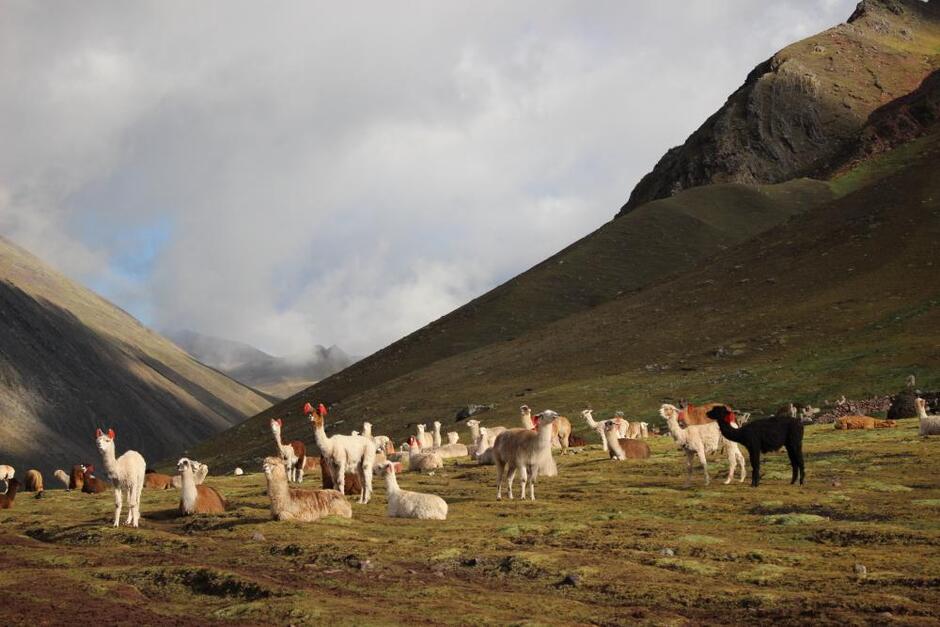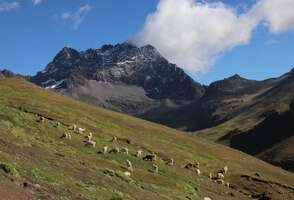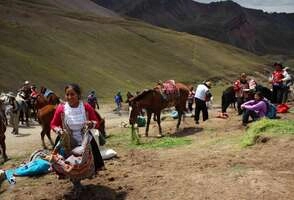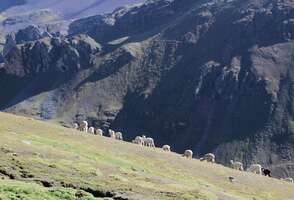
Ausangante with its 6384 m / 20940 ft elevation above sea level is the fifth highest peak in Peru (and one of the highest peaks of South America) after Huascaran, Yerupaja, Coropuna and Huandoy.
In the mid 20th century several expeditions tried to climb Ausangate. The first mountaineer was Italian Piero Ghiglione who tried to conquer Ausangate in 1950. After the first unsuccessful try he returned in 1952 with multinational expedition. But this time the expedition also failed to reach the main peak of Ausangate. Finally, in 1953 the Autsrian-German expedition became the first to reach the top of Ausangate. The first Peruvian expedition to climb Ausangate was 30 years later!
Qoyllur Rit’I Festival
Ausangate – one of the main Apu (mountain spirits) is the deity of Cuzco. During the Incan Empire the Indians worshipped and celebrated this god. After the Spanish colonisation this festival became an amalgamation of the Indian worship of mountain spirits, and the celebration of the apparition of Christ on the mountainside.

Qoyllur Rit’i is celebrated at the end of May – beginning of June and continues for several days. Qoyllur Rit’i in Quechua means “Snow Star”. This festival is held at Sinakara, at the foot of Mount Ausangate. The festival attracts more than 10 thousand pilgrims every year from surrounding villages and from all other parts of the country, even from the neighbouring countries. The arrangements start with raucous celebrations near the chapel. People in national costumes dance traditional dances. However, these are not the main events of Qoyllur Rit’i.
Groups of Queros indigenous people climb Ausangate Mountain, at 6362m, in search of the Snow Star which is reputedly buried within the mountain. The foreigners are not allowed to participate in this climb, according to the Indians, this may offend Apu Ausangate. For several days the pilgrims walk to the top of the mountain: through the dangerous paths and freezing passages, gasping for breath in the thin air, and overcoming numerous difficulties. The accidents are quite frequent – not everybody returns back (in this case, the Indians say that Apu Ausangate received its sacrifice). All of this is done for one purpose; to bring a block of ice to the Chapel. They people believe that the ice brings luck, has medical effects, and that the lands irrigated with this holy water will be very fertile.

Climbing Ausangate
Ausangate trek is not for beginners! If you think that you are experienced enough for this ascent, spend enough time in Cusco before climbing the mountain, to allow yourself time to become acclimatised to the region.
How to get there
There are two routes from Cusco to Ausangate
Route 1: Take the intercity bus to Chillca village. From there you can walk to Campo Base - the starting point of the trek (it will take you 4 to 5 hours).
Route 2: Take a bus to Tinqui village then to Pacchanta. Then continue by foot through Acepo ravine (8 to 10 hours) to Base del Ausangate – the best starting point of the trek according to most mountaineers.
If you don’t have enough experience for independent hiking, you can visit Ausangate and marvellous surrounding areas in the company of experienced guides.



Organized tours with professional guides. Group or private services. All categories of hotels.
Short group excurstions with English-speaking guides for independant travelers.
We look forward to working together to turn your dream trip into lifetime memories!